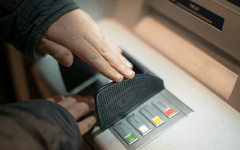There are some items on eBay that you won’t be able to buy at a fixed price. Instead, you must bid for them like you would at a real-life auction. Each participant in the auction states the maximum amount of money that they are willing to pay for the item. Whoever is willing to pay the most money for the item can buy the item at the price of the runner-up bid, plus one bid increment (i.e. the minimum amount of money that a bid can increase by).
Be careful what you bid for and how much you bid, though. A bid on eBay is, in most cases, considered to be a binding contract between you and an item’s seller. This means that if you end up being the high bidder in an auction, you are under a much stricter obligation to purchase and pay for the item that you won, as opposed to if you simply purchased the item from a seller at a fixed price. You can try to cancel your order by contacting the seller (see our how to cancel an eBay order tutorial), but for the reasons we just stated, there’s a much lower chance that they’ll agree to this.
eBay’s “automatic bidding” system
In order to make things easier on potential bidders for an item being auctioned off on eBay, the software uses an “automatic bidding” system. Basically, it allows you to place a maximum bid for an item, and then eBay automatically adjusts your current bid to beat anyone else’s maximum bid that is lower than your maximum bid, by the minimum amount allowed.
This saves you from having to log back into eBay and manually place a new bid for an item every time the highest current bid increases. Instead, you only have to manually place a new bid if the current highest bid exceeds your maximum bid (or you can decide to not place another bid if you’re not willing to pay any more money for the item).
Here’s how making an automatic bid works:
- When you go to bid on an item, you only have to put in the maximum amount of money that you want to bid on that item, at least for the moment. This is your maximum bid, and it is kept hidden from everyone else, at least until the current highest bid exceeds it.
- As long as your maximum bid is the highest one among all maximum bids from bidders currently in the auction for an item, eBay will automatically adjust your current bid to be equal to the second-highest maximum bid, plus one bid increment (i.e. the minimum amount that a bid is allowed to increase by).
- If you have the highest maximum bid for an item, and another bidder on the same item makes a higher maximum bid than you, your current bid will automatically be increased to equal your maximum bid, and the new highest bidder’s current bid will become equal to your maximum bid, plus one bid increment. At this point, eBay will send you a message notifying you that you have been outbid on an item, and will give you the opportunity to place a new maximum bid.(NOTE: Your previous maximum bid also becomes visible to other users at this point, even if you don’t place another bid. However, your user name is kept anonymous.)
Automatic Bidding Example
Suppose that Steve, Alyson, and I (i.e. Corbin) from Techboomers are all participating in an eBay auction together, and the three of us are the only participants. The opening bid for an item is $10, and the bid increment is $1. Alyson makes an opening maximum bid on the item at $15. Since there are no other bids for hers to compete against besides the opening one, the current highest bid for the item — and Alyson’s current bid — becomes $11 (i.e. the next highest bid, plus one bid increment).
I see that the current highest bid for the item is $11, so I decide to make a maximum bid of $13 (remember that, hypothetically, I know nothing about how high Alyson’s maximum bid is). Unfortunately for me, Alyson has a higher maximum bid than me, so eBay automatically adjusts Alyson’s current bid to be equal to my maximum bid, plus one bid increment — $14. eBay then automatically adjusts my current bid to be equal to my maximum bid — $13 — and sends me a message telling me that I have been outbid for this item.
At this point, I can place a new maximum bid, if I so desire. In addition, both Steve and Alyson can now see that someone made a maximum bid of $13 for this item (though, leaving aside that the three of us are the only auction participants, they won’t know that it was my bid; Steve may think it was Alyson’s bid, and Alyson may think it was Steve’s bid).
Now, let’s say that Steve enters the picture and sees the current highest bid at $14. Steve decides to go big and offer a maximum bid of $20 for the item. Now, since Steve’s maximum bid is higher than Alyson’s maximum bid, eBay automatically sets Steve’s current bid to be equal to Alyson’s maximum bid, plus one bid increment — $16. Meanwhile, Alyson’s current bid is automatically adjusted Alyson’s current bid to be equal to her maximum bid — $15 — and sends her a message telling her that she has been outbid on this item.
At this point, Alyson can place a new maximum bid, if she so desires. Also, both Steve and I can now see that someone made a maximum bid of $15 for this item (though, again, we hypothetically don’t know that this was Alyson’s maximum bid; I may think it was Steve’s, and Steve may think that it was mine).
If neither I nor Alyson place any higher bids, Steve wins the auction, and pays $16 for the item (even though he was willing to pay up to $20).
That’s an explanation of how bidding works. Our next tutorial, “How to Bid on eBay”, will show you how to actually take part in an eBay auction. We’ve also got a great article on bidding tips that can help you win your auctions.






